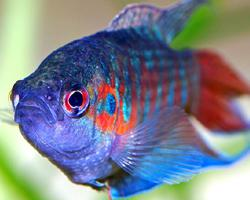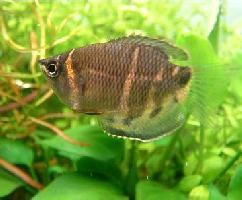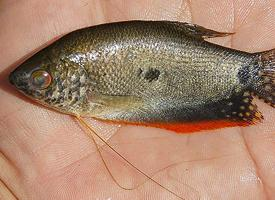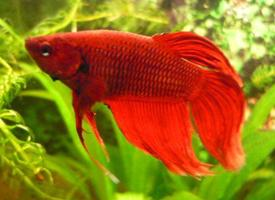
Stav ohrožení
| Neohrožen |
Popis zvířete
The Fork-tailed paradisefish, scientifically known as Macropodus opercularis, is a captivating and visually striking species within the Osphronemidae family, often admired by aquarists and nature enthusiasts alike for its beauty and unique characteristics. Native to East Asia, this species is found in a range of freshwater habitats, including ponds, rice fields, and slow-moving streams across China, Vietnam, and Korea. Its adaptability to various environmental conditions highlights its resilience and contributes to its popularity in the aquarium trade.Characterized by its vibrant colors and distinctive morphology, the Fork-tailed paradisefish can reach up to 10 centimeters (about 4 inches) in length. The body of this fish is elongated and laterally compressed, facilitating agile movement through water. One of the most notable features of this species is its forked caudal fin, which, along with its other fins, can display a breathtaking array of colors ranging from deep blues and greens to vibrant reds and oranges, depending on the fish's mood, health, and breeding condition. The intensity of these colors is more pronounced in males, especially during spawning periods when they are trying to attract females or assert dominance over rivals.
Males are also distinguished by their larger size and more elongated fins compared to females. The anal and dorsal fins of the males are particularly elongated, adding to their ornamental appearance and playing a crucial role in courtship displays. Females, while more subdued in coloration, still possess a subtle beauty and are slightly smaller and rounder in body shape.
The Fork-tailed paradisefish is an omnivore, feeding on a diet that includes small insects, crustaceans, and plant matter. In the wild, its diet is varied, which it continues in captivity, accepting most types of food offered to it. This adaptability in diet is another factor that makes it a favored species among aquarium enthusiasts.
Breeding behaviors of this species are fascinating. The Fork-tailed paradisefish is a bubble nest builder; the male constructs a floating nest out of air bubbles and plant matter at the water's surface. After an elaborate courtship display, where the male dances around the female, displaying his vibrant fins to attract her, the female lays her eggs, which the male then fertilizes and incorporates into the bubble nest. He guards the nest fiercely until the fry hatch and are capable of swimming freely.
Aquarists value the Fork-tailed paradisefish not only for its aesthetic appeal but also for its intriguing behavior and relatively easy care. However, potential keepers should be aware that males can be territorial and aggressive towards each other and other species, especially in confined spaces. Therefore, careful consideration must be given to tank size and companions to ensure a harmonious environment.
In summary, the Fork-tailed paradisefish is a fascinating and beautiful species that brings a splash of color and a glimpse of East Asian freshwater ecosystems into the home aquarium. Its resilience, intriguing behaviors, and striking appearance make it a cherished species among fish enthusiasts around the globe.
Podobná zvířata
Nové fotografie zvířat
Top 10 zvířat
- Chinese water dragon (Physignathus cocincinus)
- Galápagos tortoise (Geochelone nigra complex)
- Dolphin gull (Leucophaeus scoresbii)
- Japanese macaque (Macaca fuscata)
- Colombian red howler (Alouatta seniculus)
- Sea urchins (Echinoidea)
- Moustached guenon (Cercopithecus cephus)
- Diana monkey (Cercopithecus diana)
- Common reed warbler (Acrocephalus scirpaceus)
- Common house mosquito (Culex pipiens)


